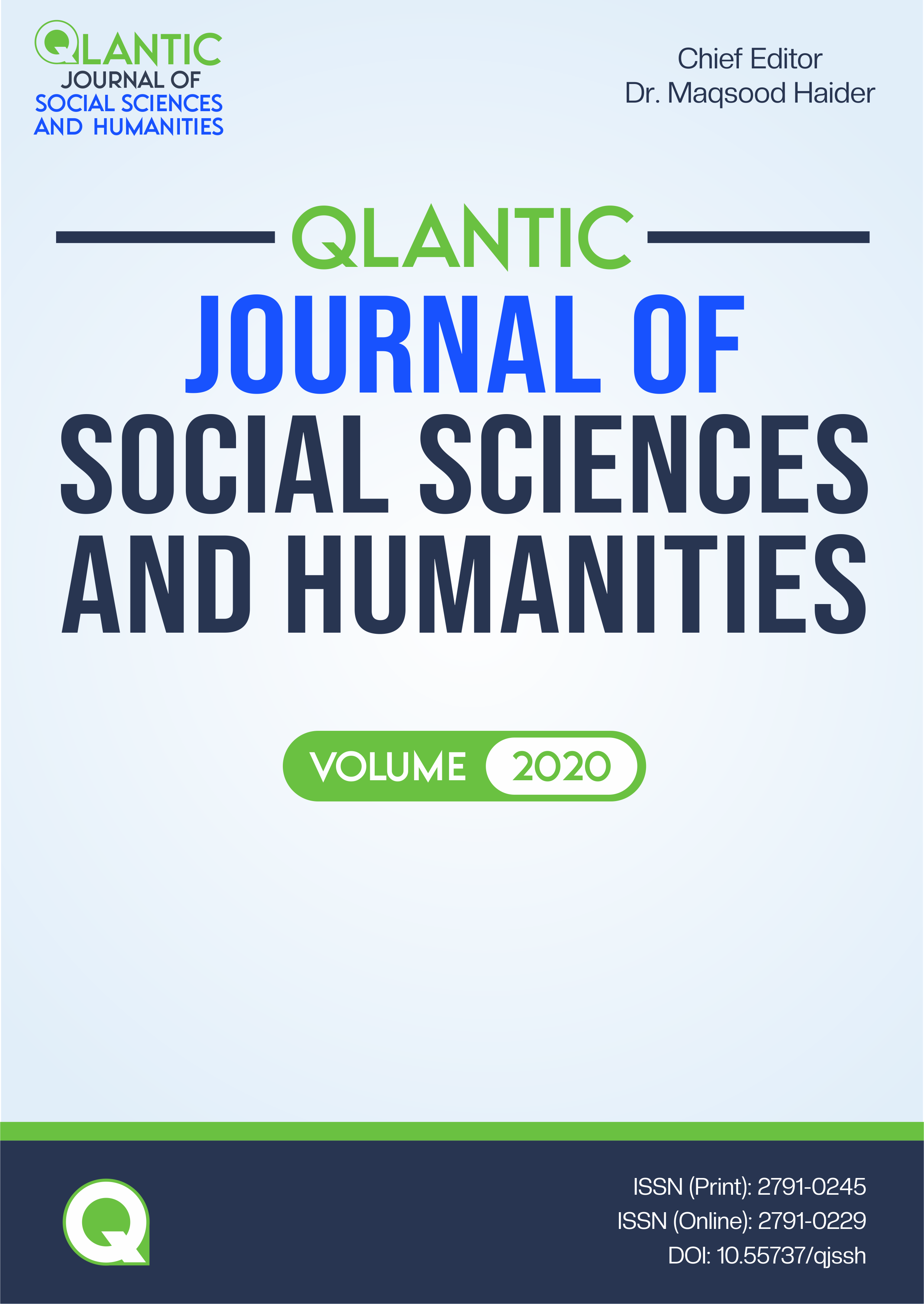Factors Responsible for Students' Dropout at Tertiary Level in District Swabi
DOI:
https://doi.org/10.55737/qjssh.386792030Keywords:
Drop Out, Tertiary Level, Socio Economic, Cultural Constraints, AcademicAbstract
The study was sought to explore the cause of students' dropout at university level. Objectives of the study were to identify the factors responsible for students' dropout related to parental socio-economic status, to find out factors responsible for students' dropout related to cultural constraint, to determine the factors responsible for students' dropout related to academic activities, to investigate the factors responsible for student's dropout related to discipline. All the 60 teachers serving in 10 affiliated colleges of education constituted population of the study. A sample of 40 teachers was randomly selected from the population to fulfill the requirement of representation. A closed-end questionnaire was developed with the consultation of supervisor containing 47 items based on Likert scale. The collected data was analyzed by using percentage as statistical tool. More than half of the respondents agreed that tense environment at home cause dropout. More than half of the teachers agreed that illiteracy of the parents causes dropout. Less than half of the respondents agreed that family enmity of the parents causes dropout. More than half of the respondents agreed that considering education unfruitful causes dropout. More than half of the individuals agreed that parent's engagement in earning causes dropout. Majority of the respondents agreed that financial problem of the children causes' dropout. Based on findings it was recommended that Parents may provide conducive environment in home to prevent dropped out. Administration should provide safety to the students, and department should provide separate campus for females, so that they ensure their society and parents that they are safe, their social rights are reserved. Administration should provide safety to the students, and department should provide separate campus for females, so that they ensure their society and parents that they are safe, their social rights are reserved.
References
Alkan, N. (2014). Humor, loneliness, and acceptance: predictors of university drop-out intentions. Proc. Soc. Behav. Sci. 152, 1079–1086. doi: 10.1016/j.sbspro.2014.09.278
Atzaba-Poria, M., Pike, A., & Deater-Deckard, K. (2004). Do risk factors for problem behaviour act in a cumulative manner? An examination of ethnic minority and majority children through an ecological perspective. J. Child Psychol. Psychiatry 45, 707–718. doi: 10.1111/j.1469-7610.2004.00265.x
Bernardo, A., Esteban, M., Fernández, E., Cervero, A., Tuero, E., & Solano, P. (2016). Comparison of personal, social, and academic variables related to university drop-out and persistence. Front. Psychol. 7:1610. doi: 10.3389/fpsyg.2016.01610
Bonaldo, L., & Pereira, L. N. (2016). Dropout: demographic profile of Brazilian university students. Proc. Soc. Behav. Sci. 228, 138–143. doi: 10.1016/j.sbspro.2016.07.020
Contini, D., Cugnata, F., & Scagni, A. (2018). Social selection in higher education. Enrolment, dropout and timely degree attainment in Italy. High. Educ. 75, 785–808. doi: 10.1007/s10734-017-0170-9
Evans, G. W., Li, D., & Whipple, S. S. (2013). Cumulative risk and child development. Psychol. Bull. 139, 1342–1396. doi: 10.1037/a0031808
Faas, C., Benson, M. J., Kaestle, E. C., & Savla, J. (2018). Socioeconomic success and mental health profiles of young adults who drop out of college. J. Youth Stud. 21, 669–686. doi: 10.1080/13676261.2017.1406598
Hällsten, M. (2017). Is education a risky investment? The scarring effect of university dropout in Sweden. Eur. Sociol. Rev. 33, 169–181. doi: 10.1093/esr/jcw053
Heublein, U. (2014). Student drop-out from German higher education institutions. Eur. J. Educ. 49, 497–513. doi: 10.1111/ejed.12097
Hovdhaugen, E. (2009). Studies in higher education transfer and dropout : different forms of student departure in Norway. Stud. High. Educ. 34, 1–17. doi: 10.1080/03075070802457009
Mabel, Z., & Britton, T. A. (2018). Leaving late: understanding the extent and predictors of college late departure. Soc. Sci. Res. 69, 34–51. doi: 10.1016/j.ssresearch.2017.10.001
Mackenzie, M. J., Kotch, J. B., Lee, L.-C., Augsberger, A., & Hutto, N. (2011). A cumulative ecological–transactional risk model of child maltreatment and behavioral outcomes: reconceptualizing early maltreatment report as risk factor. Child. Youth Serv. Rev. 33, 2392–2398. doi: 10.1016/j.childyouth.2011.08.030
Melguizo, T., Torres, F. S., & Jaime, H. (2011). The association between financial aid availability and the college dropout rates in Colombia. High. Educ. 62, 231–247. doi: 10.1007/s10734-010-9385-8
O'Neill, L. D., Wallstedt, B., Eika, B., & Hartvigsen, J. (2011). Factors associated with dropout in medical education: a literature review. Med. Educ. 45, 440–454. doi: 10.1111/j.1365-2923.2010.03898.x
Ortiz, E. A., & Dehon, C. (2013). Roads to success in the Belgian French community's higher education system: predictors of dropout Bruxelles. Res. High. Educ. 54, 693–723. doi: 10.1007/s11162-013-9290-y
Paterson, N. D. (2017). Predictors of first year retention rates at the university of the west Indies, Jamaica. Int. J. Educ. Dev. 55, 63–68. doi: 10.1016/j.ijedudev.2017.06.001
Sarra, A., Fontanella, L., & Di Zio, S. (2018). Identifying students at risk of academic failure within the educational data mining framework. Soc. Ind. Res. 1–20. doi: 10.1007/s11205-018-1901-8
Sittichai, R. (2012). Why are there dropouts among university students? Experiences in a Thai university. Int. J. Educ. Dev. 32, 283–289. doi: 10.1016/j.ijedudev.2011.04.010
Solomon, D., Åsberg, K., Peer, S., & Prince, G. (2016). Cumulative risk hypothesis: predicting and preventing child maltreatment recidivism. Child Abuse Neglect. 58, 80–90. doi: 10.1016/j.chiabu.2016.06.012
Stewart, S., Lim, D. H., & Kim, J. H. (2015). Factors influencing college persistence for first-time students. J. Dev. Educ. 38, 12–20.
Stratton, L. S., O'Toole, D. M., & Wetzel, J. N. (2008). A multinomial logit model of college stopout and dropout behavior. Econ. Educ. Rev. 27, 319–331. doi: 10.1016/j.econedurev.2007.04.003
Tinto, V. (1975). Dropout from higher education: a theoretical synthesis of recent research. Rev. Educ. Res. 45, 89–125. doi: 10.3102/00346543045001089
Voelkle, M. C., & Sander, N. (2008). A structural equation approach to discrete-time survival analysis. J. Individ. 29, 134–147. doi: 10.1027/1614-0001.29.3.1
Published
Issue
Section
License
Copyright (c) 2020 Saba Gul

This work is licensed under a Creative Commons Attribution-NonCommercial 4.0 International License.





